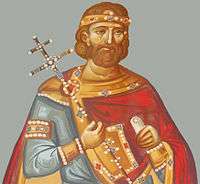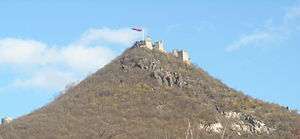Vukan, Grand Prince of Serbia
| Vukan | |
|---|---|
| Grand Prince of Serbia | |
 | |
| Grand Prince of Serbia | |
| Reign | 1091–1112 |
| Predecessor | Constantine Bodin |
| Successor | Uroš I |
| Prince of Rascia | |
| Reign | 1083–1091 |
| Predecessor | Petrislav |
| Successor | Uroš I |
| Born | c. 1050 |
| Died | 1112[a] |
| Dynasty | Vukanović |
| Father | Petrislav |
| Religion | Eastern Orthodox |
Vukan (Serbian: Вукан, Greek: Βολκάνος; c. 1050 – 1115) was the Grand Prince of Serbia (Rascia) from 1083 until his death in 1112. He ruled together with his brother, Marko. With the death of his uncle Constantine Bodin in 1101, he becomes the most powerful ruler of the Serbian principalities. He defeated the Byzantines several times, conquering parts of north Macedonia. He is the eponymous founder of the Vukanović dynasty.
Vukan was the first-born of Petrislav, the son of King Mihailo I and his second Greek wife.[1] He and his brother Marko swore an oath of loyalty to Constantine Bodin and took power as his vassals in Rascia in 1083 or 1084.[1] Marko later disappears from sources.[1] Neither Bosnia, Zachlumia nor Rascia were ever integrated into Duklja. Each Županate had its own nobility and institutions and acquired a Vojislavljević to head as Župan.[1]
In 1089, Bodin managed to raise the bishopric of Bar to an Archbishopric, by supporting the pope against an antipope. The suffragan bishops were to be: Kotor, Ulcinj, Svac, Skadar, Drivast, Pula, Ras, Bosnia and Trebinje.[1] In obtaining its promotion, it acquired a much larger diocese, including territory that earlier had not been under the pope – territories of the metropolitan of Durazzo and Archbishop of Ochrid, two sees that recognized the jurisdiction of the Ecumenical Patriarchate of Constantinople.[1] The Bar Archbishopric's new territory were merely theoretical – the pope's edict could only affect the churches that recognized Rome.[1] Making Rascia a suffragan to Bar had little meaning, as most of its churches were under Constantinople, and there is none evidence of Vukan changing adherence to Rome.[1] Durazzo and Ochrid may have suffered minimal territorial losses along the coast, Duklja was briefly a subject to Rome, however inland Duklja was not affected, and along with much of Duklja's coast (like most of Kotor) was to retain its loyalty to Orthodoxy.[1]
A Byzantine campaign was launched against Duklja between 1089 and 1091, possibly managing to take Bodin captive for a second time.[2] Civil war broke out in the realm among Bodin's relatives, greatly weakening Duklja, giving the chance for Rascia to assert itself and break away.[2] Vukan asserts independence, as well as Bosnia and Zahumlje.[2] Up to this point, Duklja had been the center of the Serbian realm, as well as the main resistance to Byzantium in the Balkans.[2] Rascia becames the most powerful of Serbian states, remaining so throughout the Middle Ages.[3] Rascia, of which was the prestige rose, replaced Duklja as the main opponent of Byzantine rule in the 12th century.[2] Bodin's heirs were forced to recognize Byzantine overlordship, and had now only the small territory of Duklja and Travunia.[2]
In 1091 or 1092, Vukan became independent,[2] taking the title of Grand Prince (Veliki Župan).[3] His state was centered on present-day Novi Pazar.[3] Subordinate to him were local dukes (Župan, holding a territory equivalent of a county), who seem to have been more or less autonomous in the internal affairs of their counties, but who were obliged to be loyal to Vukan, and supporting him in battle.[3] It seems that the dukes were hereditary holders of their counties, holding their land before Duklja annexed Rascia.[3]
In about 1090, Vukan began raiding Byzantine territory, first in the vicinity of Kosovo.[3] Initially the Byzantines were unable to take steps against Vukan, as they faced a serious threat in the invading Pechenegs.[4] On 29 April 1091, the Byzantines destroyed the Pecheneg force.[4] With the defeat of the Pechenegs, Alexios I Komnenos could now turn to the Serbs.[4]

Alexios I first sent an army with the strategos of Durazzo, which was defeated by Vukan in 1092.[4] The Emperor now mobilized a much larger army, led by himself, marching onto Rascia.[4] Vukan sends envoys, seeking peace which Alexios I quickly accepted, as a new problem had arisen at home in the Cumans who plundered the lands as far as Adrianople.[4] Immediately after the Emperor's departure, Vukan breaks the treaty, and began to expand along the Vardar, obtaining much booty and taking the cities of Vranje, Skopje and Tetovo.[4] In 1094 or 1095, Alexios I marched out to meet the Serbs. Vukan and his dukes arrive at the Emperor's tent and offer peace, with his own son Uros I as hostage (throughout the 12th century it was usual for relatives of the Grand Prince to stay at the imperial court as hostages of peace).[4]
At this time, Rascia was independent – Vukan acted entirely on his own, no longer a vassal of Duklja.[4] Duklja, because of its civil war, did not involve itself in the Rascian-Byzantine wars.[4]
Vukan again marched south, into Macedonia. Alexios could not do anything about him as the Crusade took place. In 1106 Vukan submitted to Alexios.[5]
Following Bodin's death in 1101, Bodin's half-brother Dobroslav II succeeded him as king of Doclea. Kočopar Branislavljević, Bodin's first cousin once removed, travelled from Dyrrhachium to Rascia, forging an alliance with Vukan. This alliance would prove worthy in their successful invasion of Doclea in 1102. The battle that ensued at the Morača led to the overthrow of Dobroslav II and the coronation of Kočopar to the throne. Dobroslav was subsequently banished to Rascia. However, Kočopar's reign was short-lived as well as Vukan had been planning to install Bodin's nephew, Vladimir to the Doclean throne. Kočopar, having lost influence among the Zachlumoi, married the daughter of a Zachlumian (Bosnian) prince (knez). However, in the Chronicle of the Priest of Duklja, the chronicler specifically mentioned that at the time, Zachlumia was ruled by a ban, not a knez. Kočopar later died in battle against the Zachlumoi. Upon his death, Vukan installed Bodin's nephew Vladimir as planned, to whom he gave his daughter as a wife and so strengthened ties between Rascia and Doclea. A mere pawn in dynastic conflicts, Vladimir was poisoned in 1118 under orders from Queen Jaquinta, widow of his late uncle, Constantine Bodin. Jaquinta then appointed her son, George, to the Doclean throne.
Upon spreading his influence in Doclea, Vukan invaded Byzantium once more in the spring of 1106. He was probably attempting to take advantage of the Norman campaign against the Byzantines (see Byzantine–Norman wars). In a battle, he defeated John II Komnenos again. The war was concluded by November of that year, with Vukan being forced to send hostages once again to emperor Alexios I in return for peace. There is no written record of Vukan after this war.
Scholars believe Vukan died after 1112.[a] Vukan's successor was Uroš I his nephew through Marko.
Legacy
William of Tyre called him "King of the Slavs" (rex Sclavorum).[6][7]
| Vukan Born: ~1050 Died: 1112 | ||
| Regnal titles | ||
|---|---|---|
| Preceded by Constantine Bodin seat at Duklja |
Grand Prince of Serbia 1091–1112 |
Succeeded by Uroš I |
| Royal titles | ||
| Preceded by Petrislav |
Župan of Raška under Constantine Bodin 1083–1091 with Marko |
Grand Prince |
References
- 1 2 3 4 5 6 7 8 9 The early medieval Balkans, p. 223
- 1 2 3 4 5 6 7 The early medieval Balkans, p. 224
- 1 2 3 4 5 6 The early medieval Balkans, p. 225
- 1 2 3 4 5 6 7 8 9 10 The early medieval Balkans, p. 226
- ↑ The early medieval Balkans, p. 228
- ↑ Francis W. Carter (1972). Dubrovnik (Ragusa): A Classic City-state. Seminar Press. p. 131. ISBN 978-0-12-812950-0.
- ↑ Pavel Josef Šafařík (1863). Sebrané spisy: Slovanské starožitnosti. Tempský. pp. 270–.
- ↑ Zivkovic, hipoteza, p. 15
- ↑ The early medieval Balkans, p. 298
Sources
- Anna Comnena, The Alexiad, translated by Elizabeth A. Dawes in 1928
- Komatina, Ivana (2015). "Srpski vladari u Aleksijadi - hronološki okviri delovanja" [Serbian rulers in the Alexiad - some chronological notes] (PDF). ZRVI. LII.
- John Kinnamos, The Deeds of John and Manuel Comnenus, trans. C.M. Brand (New York, 1976). ISBN 0-231-04080-6
- Imperii Graeci Historia, ed. Hieronymus Wolf, 1557, in Greek with parallel Latin translation. (PDF of 1593 reprint)
- Živković Tibor, 2005, br. 52, str. 9–22, Jedna hipoteza o poreklu velikog župana Uroša I
- Živković, Tibor (2008). Forging unity: The South Slavs between East and West 550-1150. Belgrade: The Institute of History, Čigoja štampa.